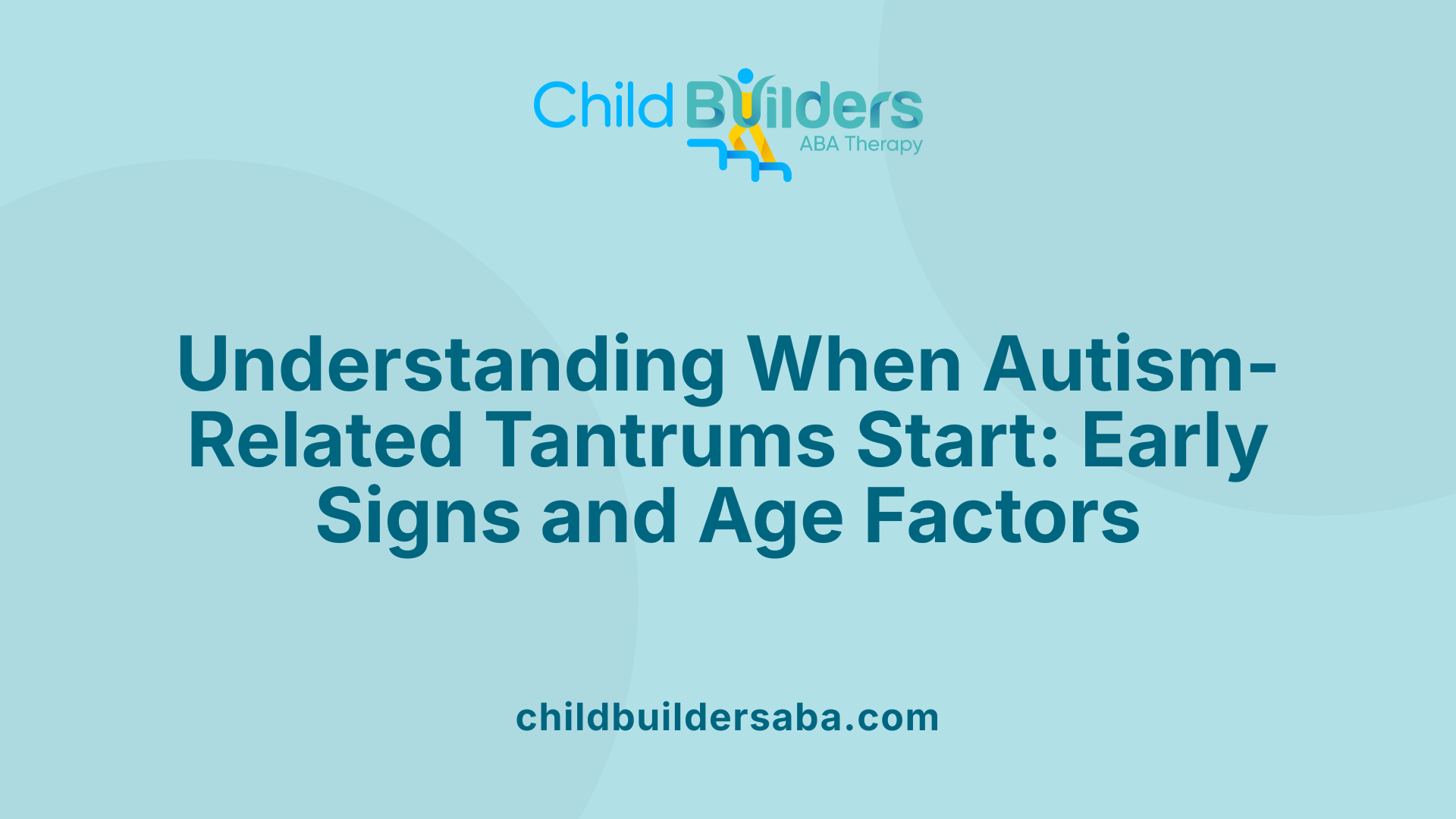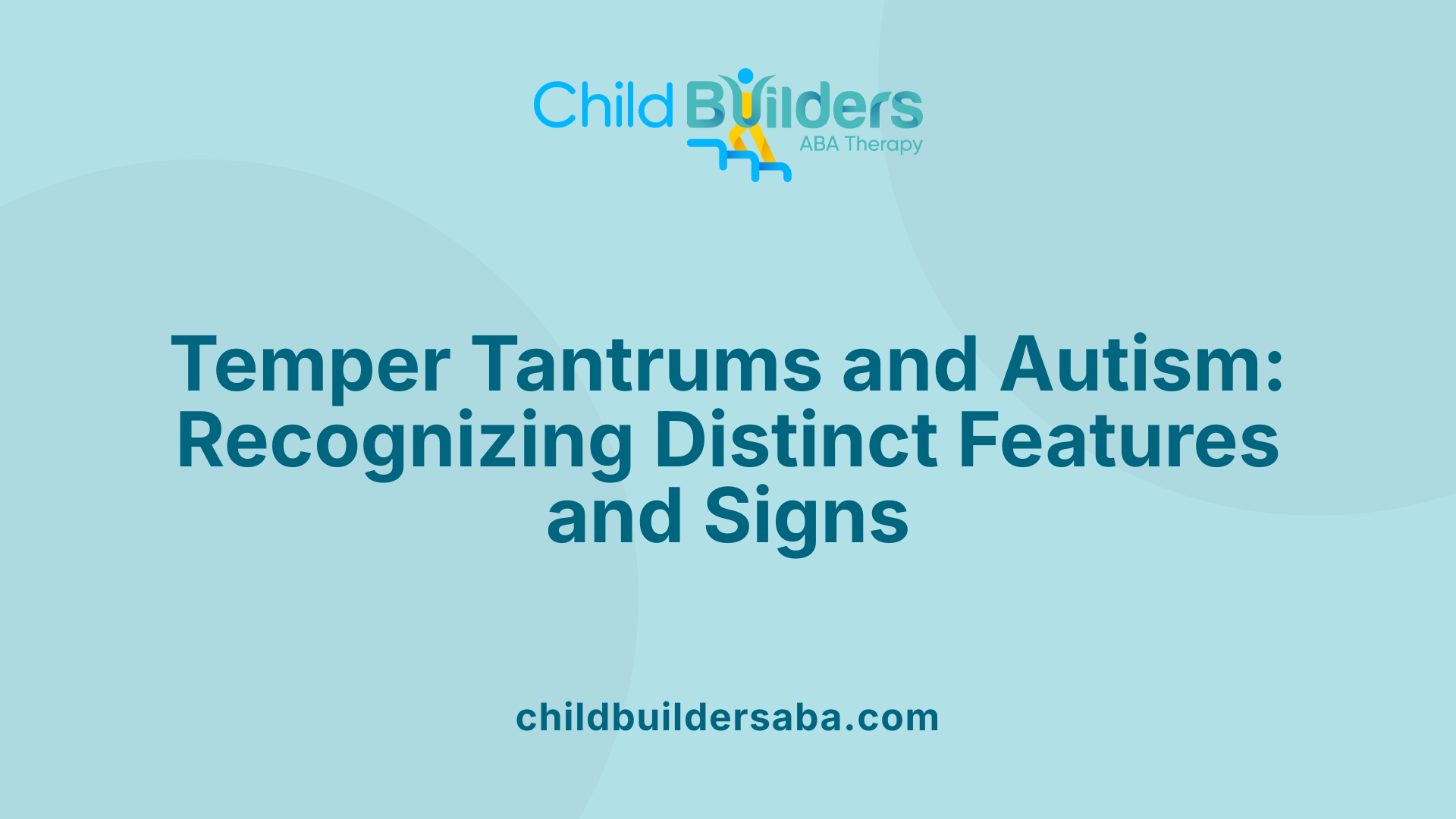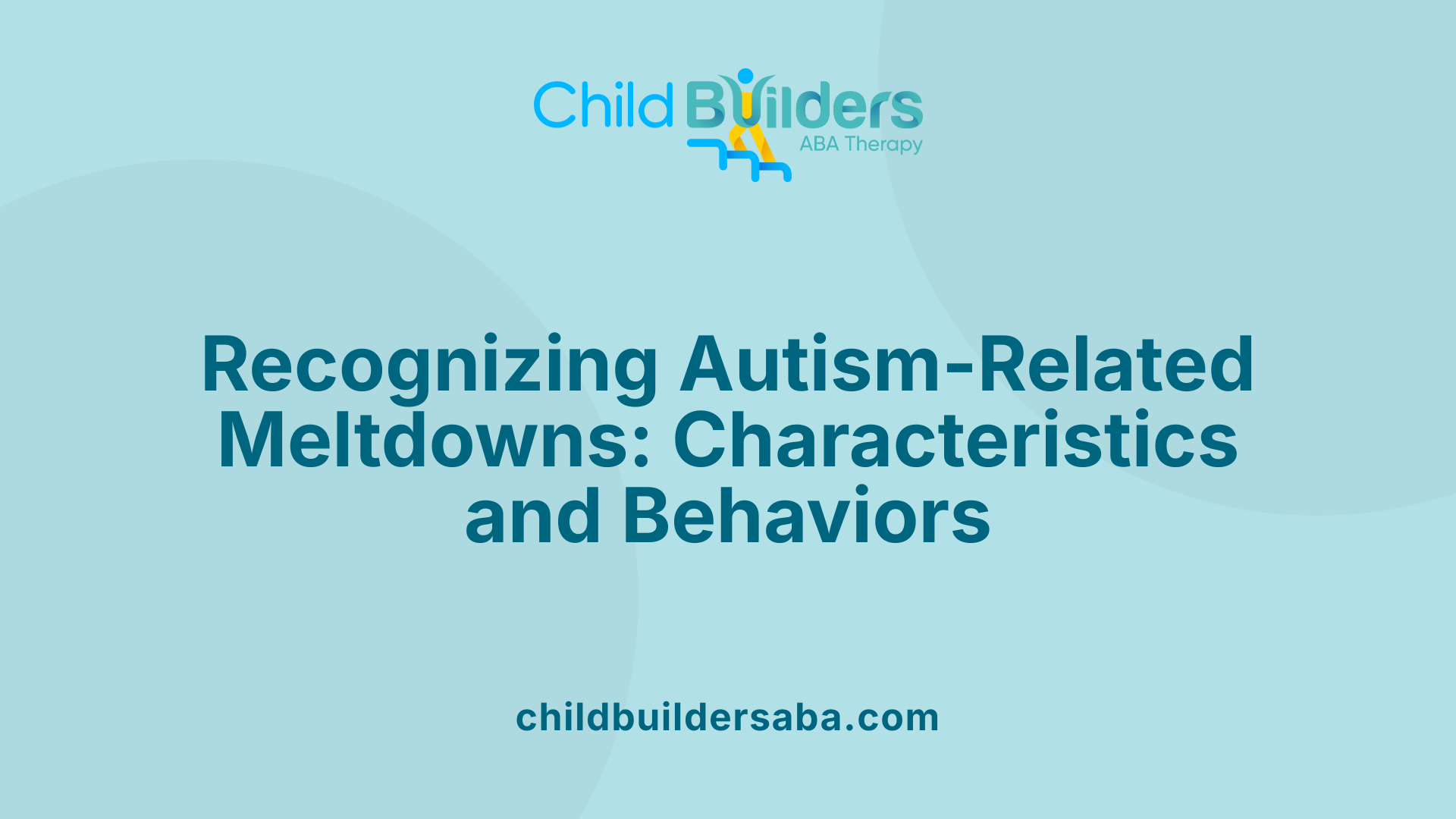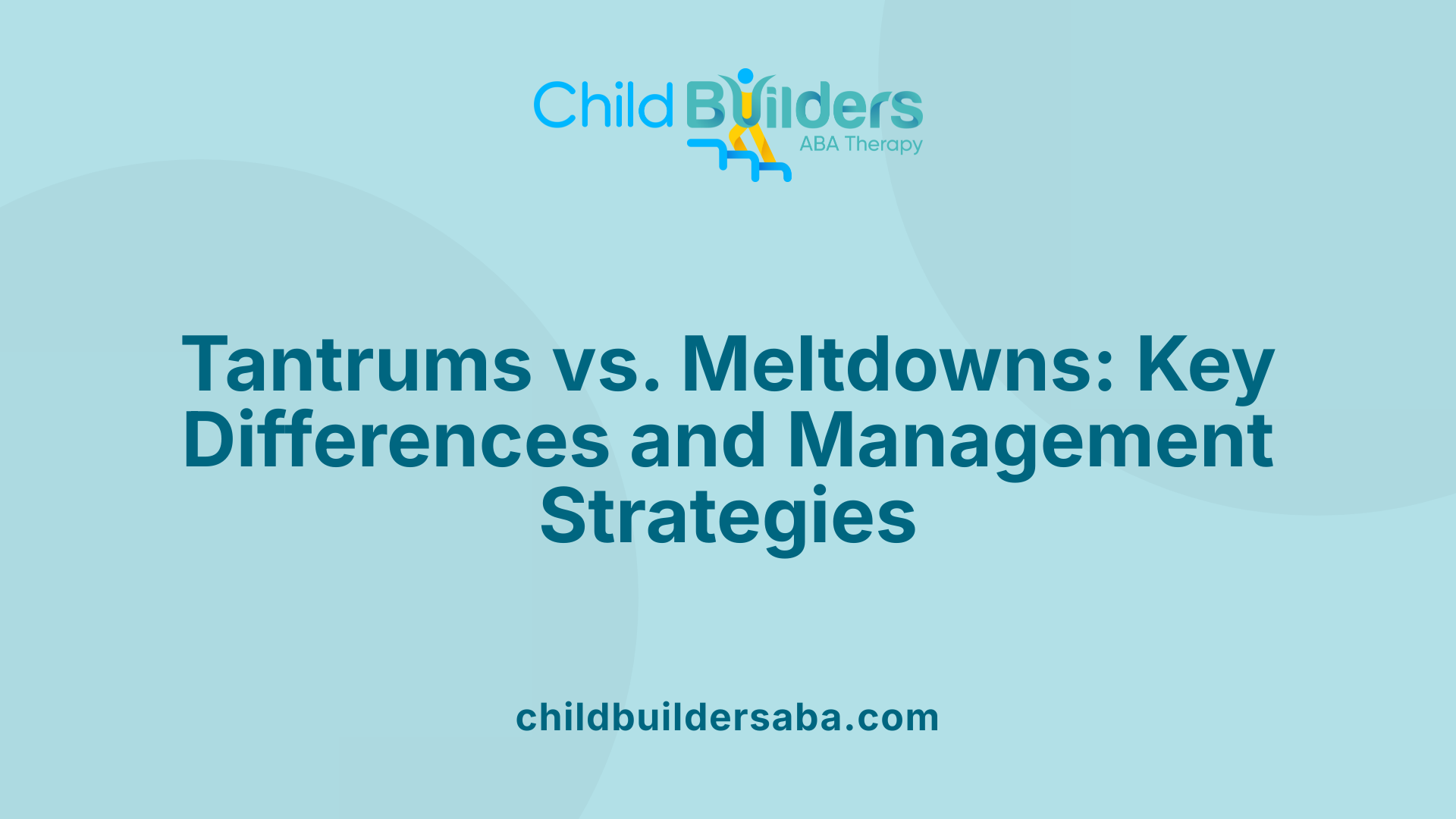Temper Tantrums A Sign Of Autism

Understanding the Significance of Temper Tantrums and Meltdowns
Temper tantrums are a common developmental phase in most children, helping them learn emotional regulation. However, when these outbursts become intense, frequent, or prolonged, they may signal underlying developmental concerns, such as autism spectrum disorder (ASD). Recognizing the difference between typical tantrums and those related to autism is vital for early intervention and effective support. This article explores how tantrums and meltdowns can serve as early indicators of autism, the key differences between these behaviors, and strategies for management.
When Do Autism-Related Tantrums Typically Begin?

At what age do children with autism typically start having tantrums?
Children with autism can begin experiencing tantrums as early as around 12 months of age. However, they are most commonly observed between ages two and three. Early tantrums in autistic children may be more intense, longer-lasting, and disproportionate compared to those seen in typically developing children.
Several factors contribute to the early onset of tantrums in children with autism. Difficulties with communication often make it challenging for children to express their needs or frustrations, leading to emotional outbursts. Sensory sensitivities, such as overreactions to sounds, textures, or lights, can also play a significant role. Additionally, increased environmental demands or routine changes may trigger these episodes.
It is essential to distinguish between tantrums and meltdowns. While tantrums are goal-directed behaviors usually aimed at obtaining something or expressing a desire, meltdowns tend to occur as uncontrollable reactions to sensory overload without any clear goal. Typically, tantrums tend to decrease in frequency and intensity as children grow older and develop more effective coping and communication skills.
Understanding the timing and patterns of tantrums can help caregivers and professionals support children better, helping them learn emotional regulation and reduce distressing episodes.
Are Temper Tantrums a Clear Indicator of Autism?

Are temper tantrums indicative of autism?
Temper tantrums are common in childhood and usually reflect frustration or unmet needs. These behaviors are typically goal-oriented, such as trying to communicate a desire or get attention. Young children often throw tantrums when they are overwhelmed or if they cannot express themselves clearly.
However, autism-related outbursts or meltdowns have distinct features. They are not driven by a desire to gain attention or achieve a specific goal. Instead, meltdowns result from sensory overload—such as loud noises, bright lights, or physical discomfort—or emotional overwhelm. They can occur at any age and tend to be more intense and longer-lasting.
Signs that differentiate autism-related responses include difficulties in communication, unusual sensory sensitivities, and repetitive or unusual body movements. Children with autism may also show limited social engagement, reduced eye contact, and atypical play behaviors.
While severe or frequent tantrums might raise concerns, they are not exclusive to autism. Many children experience temper tantrums as part of normal development. Nevertheless, if a child's outbursts are persistent, intense, and accompanied by other signs like communication delays or sensory sensitivities, it is important to seek a professional assessment.
Proper diagnosis is crucial, as it helps distinguish typical developmental behaviors from those linked to autism or sensory processing challenges. Understanding these differences allows caregivers and educators to adopt appropriate support and intervention strategies, fostering better emotional regulation and social skills.
Are Tantrums Alone Sufficient for Autism Diagnosis?

Are tantrums alone reliable for diagnosing autism?
Tantrums are a common part of emotional development in young children and cannot be solely used to diagnose autism. While children with autism may engage in longer and more intense meltdowns, these behaviors are not exclusive to autism and can occur in other children as well.
Typically, tantrums last about 15 minutes, happen 2-5 times a day, and are triggered by specific situations such as frustration, unmet needs, or environmental changes. Children with autism often experience more prolonged and frequent meltdowns that may last hours, especially when affected by sensory sensitivities or routine disruptions.
Behavioral patterns are essential when considering autism, but they should be evaluated alongside other signs. For example, early indicators such as limited eye contact, repetitive movements, unusual sensory reactions, and delayed language development are more indicative of autism.
Misinterpreting tantrums as a symptom of autism can lead to misdiagnosis or delays in receiving appropriate support. Therefore, clinicians recommend a full assessment that includes behavioral observations, developmental history, and possibly standardized testing.
In summary, tantrums alone are not reliable for diagnosing autism. Recognizing the broader spectrum of behaviors and developmental markers is crucial for an accurate diagnosis and effective intervention.
| Aspect | Typical Behavior | Autism-Related Signs | Additional Notes |
|---|---|---|---|
| Duration | ~15 minutes | Can last hours | Meltdowns in autism are often more intense and persistent |
| Triggers | Specific situations | Sensory overload, routines | Sensory sensitivities are common in autism |
| Behavior | Goal-oriented | Uncontrollable, sometimes harmful | Meltdowns are involuntary responses |
| Communication | Usually develops over time | Delays or differences | Autism often involves communication challenges |
| Response | Influenced by others | Occur regardless of others' reactions | Meltdowns happen even when alone |
Understanding the limitations of using tantrums alone underscores the need for comprehensive developmental evaluation. Early detection of autism involves observing multiple behaviors and developmental signs beyond emotional outbursts.
What Do Autism-Related Meltdowns Look Like?

Characteristics of autistic meltdowns
Autism-related meltdowns are intense episodes of overwhelm caused by sensory, emotional, or environmental overload. Unlike typical temper tantrums, which often have a clear goal, meltdowns are involuntary reactions rooted in the brain's inability to process excessive stimuli.
During these episodes, individuals may exhibit a range of physical and emotional behaviors that reflect their extreme distress. These behaviors include crying, screaming, flailing fists or limbs, hitting, or withdrawal into silence or shutdown. In some cases, the person may engage in self-injurious acts such as head-banging, skin-picking, or repetitive, intense stimming.
Meltdowns can happen suddenly and may escalate quickly if the individual feels overwhelmed. They are often triggered by sensory sensitivities, such as loud noises, bright lights, or certain textures, or by changes in routine and routine disruptions. Communication difficulties and anxiety also play roles in precipitating these episodes.
Physical and emotional behaviors during meltdowns
During a meltdown, physical reactions like kicking, biting, or throwing objects are common. Emotionally, a person may scream, cry uncontrollably, or become non-responsive. They often display signs of extreme frustration or fear, and in some cases, they may attempt to escape the stressful situation.
They are generally not goal-oriented but are instead automatic responses to being overwhelmed. Some individuals might show signs of distress even before the meltdown fully begins, such as pacing, fidgeting, or increased stimming behaviors like hand-flapping or humming.
Duration and triggers of meltdowns
Autistic meltdowns can last from several minutes to over an hour, depending largely on the severity of overload and individual circumstances. Unlike tantrums, which are often resolved quickly once the person's demands are met or ignored, meltdowns tend to continue until the individual can regain some sense of control or the overload diminishes.
Common triggers include sensory overload from loud environments, bright or saturated colors, physical discomfort from tags or itchy clothing, or unexpected changes in routine. Over-stimulation from crowded places or demanding schedules can also set off a meltdown.
Understanding these patterns helps caregivers and educators support individuals with autism during difficult episodes, emphasizing the importance of calm, patience, and creating a safe space.
Differences Between Typical Tantrums and Autism-Related Meltdowns

What are the differences between typical tantrums and autistic meltdowns?
Understanding how tantrums differ from meltdowns is vital for providing appropriate support. Typical tantrums are generally goal-oriented behaviors. Children often throw tantrums to get something they want, express frustration, or seek attention. These behaviors usually stop when their demands are met or they are ignored. Children are often aware of their actions during tantrums, and these episodes are motivated by specific desires.
In contrast, autistic meltdowns are involuntary responses rather than intentional behaviors. They are triggered by overwhelming sensory inputs, emotional stress, or environmental changes. Meltdowns can happen at any age, not just during childhood, and are characterized by a loss of control. The reactions include intense screaming, crying, aggression, or even shutdown behaviors. Unlike tantrums, meltdowns cannot be easily stopped by giving a child what they want or by distractions.
Behaviorally, tantrums often involve object throwing, yelling, or stomping, and may be influenced by reinforcement—children might learn that certain behaviors lead to a desired outcome. Conversely, meltdowns are extreme responses that are not goal-directed or manipulatory in nature. These episodes can include severe behaviors such as head-banging or self-harm, and they typically require calming, supportive interventions rather than punishment.
Triggers also differ: tantrums are commonly triggered by the child's frustration or unmet needs, whereas meltdowns typically result from sensory overload, unexpected routines, or unsuitable environments. Responding effectively depends on recognizing whether the behavior is a tantrum or a meltdown, as each requires different management strategies.
| Feature | Typical Tantrums | Autism-Related Meltdowns | Additional Insights |
|---|---|---|---|
| Purpose | Goal-oriented, seeking attention or item | Involuntary response, overwhelmed by stimuli | Meltdowns are not manipulative; they stem from sensory overload |
| Behavior | Yelling, crying, object throwing | Screaming, crying, aggression, shutdowns, self-harm | Severity and duration can vary widely |
| Control | Child might have some control | Loss of control due to overload | Management focuses on calming rather than behavior correction |
| Triggers | Frustration, unmet needs | Sensory overload, environmental changes | Recognizing triggers helps in prevention and support efforts |
| Audience or presence | Presence influences behavior | Occurs regardless of audience presence | Understanding these differences ensures better responses and care. |
Early Signs of Autism Related to Behavior Outbursts
What are early signs of autism related to tantrums and meltdowns?
Identifying early signs of autism involves observing specific behavioral patterns that may distinguish autism-related outbursts from typical childhood tantrums. Children with autism often experience more frequent, intense episodes that last longer than usual tantrums, sometimes extending hours.
Sensory sensitivities are common indicators. For example, children might react strongly to sounds, textures, or lights—covering their ears or eyes, or becoming visibly distressed in crowded or noisy places. Repetitive behaviors such as hand-flapping, rocking, or pacing are also signs that a child may be overwhelmed or overloaded.
Communication challenges are significant. Children who do not respond to their name, have limited speech, or struggle to express needs are more prone to frustration. This can lead to tantrums or meltdowns when their attempts to communicate are misunderstood or ignored.
Behavioral cues such as sudden changes in routine, resistance to new stimuli, or maladaptive actions like head-banging, self-harm, or aggressive behaviors may prelude or accompany meltdowns. Recognizing these signs early is essential for distinguishing between typical frustration and autism-related reactions.
Understanding these early warning signals can guide parents, caregivers, and professionals to seek timely assessments and tailored interventions. This proactive approach may improve the child's ability to cope with sensory and social challenges, contributing to better long-term outcomes.
Is Screaming a Common Sign of Autism in Toddlers?
Prevalence of screaming behaviors among autistic toddlers
Screaming is frequently observed in toddlers with autism, often serving as a form of communication or an outlet for expressing their feelings. Due to challenges in verbal communication, many autistic children use screaming to signal distress, discomfort, or the need for attention. This behavior is quite common, especially during moments of sensory overload or emotional difficulty.
Situations eliciting screaming
Certain situations can trigger intense screaming in children with autism. These include exposure to loud noises, bright lights, or overwhelming environments that exceed their sensory threshold. Additionally, frustration from not being able to communicate their needs or cope with changes in routine can lead to screaming episodes. Meltdowns, which are involuntary overreactions to sensory or emotional overload, often involve screaming as part of their expression.
Interpretation of screaming in context
Understanding screaming in children with autism requires considering the context. While occasional screaming can be part of typical toddler behavior, frequent or intense episodes may signal underlying issues. When combined with other signs such as limited eye contact, unusual sensory reactions, or lack of social engagement, frequent screaming could suggest autism.
Table: Differentiating Normal Toddler Screaming from Autism-Related Screaming
| Aspect | Typical Toddler Screaming | Autistic Toddler Screaming | Explanation |
|---|---|---|---|
| Frequency | Occasional | Frequent, multiple times daily | Autism may involve more persistent behaviors |
| Triggers | Frustration or excitement | Sensory overload, routine changes | Autism-related screams often linked to sensory issues |
| Duration | Short-lived (a few seconds to minutes) | Longer, could last hours in meltdowns | Intensity and duration provide clues |
| Context | Usually goal-oriented, stops when needs are met or ignored | Less goal-oriented, ongoing regardless of response | Behavior patterns differ in purpose |
When to seek professional help
If screaming episodes are severe, persistent, or accompanied by other developmental concerns—such as limited social interactions, unusual sensory responses, or delays in speech—consulting a healthcare professional is advisable. Early assessment and intervention can significantly improve outcomes.
In summary, while screaming can be a common part of toddler behavior, in children with autism it frequently occurs in response to sensory overload and frustration. Recognizing the pattern and context of these episodes helps caregivers determine when additional support or evaluation may be necessary.
Strategies for Managing Tantrums and Meltdowns in Autistic Children
How can parents effectively manage tantrums and meltdowns in autistic children?
Managing tantrums and meltdowns in autistic children requires a nuanced understanding of their distinct triggers and behaviors. Tantrums are often goal-oriented, driven by frustration when a child cannot communicate needs or obtain a desired object. In contrast, meltdowns are involuntary, response to overwhelming sensory or emotional overload.
Creating a Calm Environment is essential. Parents should establish a quiet, safe space where a child can retreat during moments of distress. Soft lighting, minimal noise, and comforting objects can provide reassurance.
Techniques for Emotional Regulation include teaching children deep-breathing exercises, using visual aids like emotion charts, or practicing mindfulness activities designed for children with ASD. These methods can help children regain control before situations escalate.
Use of Sensory Tools and Routines offers additional support. Sensory diets incorporating items like noise-canceling headphones, textured toys, or weighted blankets can address sensory sensitivities. Consistent daily routines help children understand what to expect, reducing anxiety and preventing meltdowns.
Professional Support and Interventions such as Applied Behavior Analysis (ABA) therapy and consultation with occupational therapists can provide tailored strategies. Creating personalized sensory kits containing preferred items and visual schedules can be integral components of a comprehensive plan. Collaboration with educators and therapists ensures approaches are consistent and effective.
Implementing these strategies not only helps in managing immediate episodes but also encourages emotional development over time, fostering resilience and independence in children with autism.
Recognizing and Responding to Autism-Related Outbursts
Early recognition of unusual or intense tantrums and meltdowns can facilitate timely intervention, which is crucial for supporting children with autism. Differentiating goal-oriented tantrums from involuntary meltdowns helps guide appropriate responses—calm support, sensory regulation, and environmental adjustments. Seeking professional assessments when behaviors are severe or persistent ensures comprehensive understanding and tailored intervention. With targeted strategies, parents and caregivers can improve the emotional well-being and social development of autistic children, fostering a supportive environment that minimizes distress and promotes positive growth.
References
- Are Tantrums a Sign of Autism? | Managing Meltdowns
- Early Signs of Autism - UCSD Neurosciences
- Managing Autism Meltdowns, Tantrums and Aggression
- Seven Differences Between Tantrums vs Autism Meltdowns - Experia
- Tantrum vs Autistic Meltdown: What Is The Difference?
- Are Tantrums a Sign of Autism? | Managing Meltdowns
- [PDF] Early Warning Signs of Autism Spectrum Disorder - CDC
- Managing Autism Meltdowns, Tantrums and Aggression
- Seven Differences Between Tantrums vs Autism Meltdowns - Experia
- [PDF] Early Warning Signs of Autism Spectrum Disorder - CDC



.jpg)

































































































